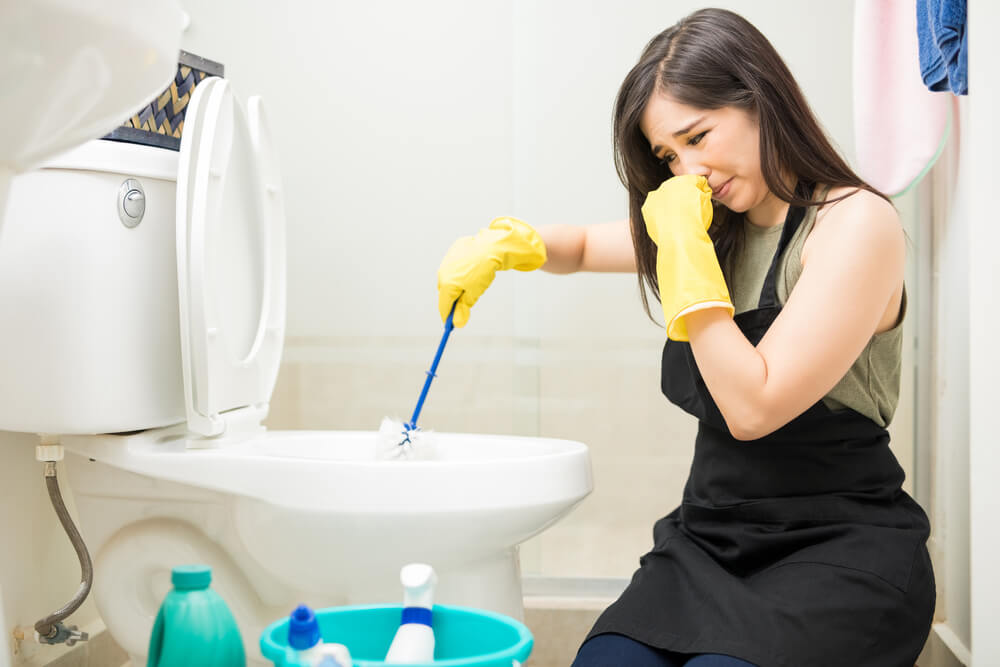To get rid of sewer smell in your house, find and fix dry P-traps, clean out drains, check toilet seals, clear blocked vents, and repair cracked pipes. A strong sewer odor in your home usually means gases from your plumbing system are leaking through cracks, loose seals, clogged vents, or dried-out traps. It smells awful and if left alone, it can get worse. In this guide, you’ll learn where that smell might be coming from and how to fix it yourself in most cases.
Table of Content
Why Does My House Smell Like a Sewer?
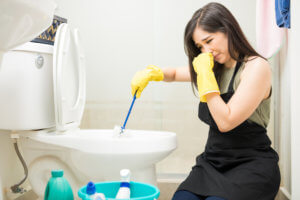
Sewer odor inside your home is a sign that sewer gases are leaking somewhere they shouldn’t. This usually means a seal is broken, a pipe is clogged, or a fixture has dried out. It’s important to fix it fast not just because of the smell, but also because long-term exposure to sewer gas can be unsafe and damaging.
Let’s break down the most common causes by location in your house.
1. Bathroom: Check Your Toilet and Shower Area
The bathroom is the first place most people suspect and for good reason. Sewer smells often start here, but the toilet isn’t always the only source.
Toilet Wax Ring Issues
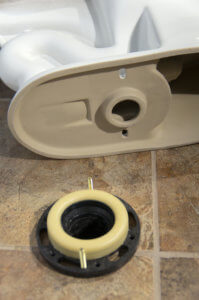
Toilet Wax Ring
Underneath your toilet, there’s a wax ring that seals the base to the drain pipe. If that ring is cracked, dried out, or loose, sewer gas can escape right into your bathroom.
How to tell:
- The toilet wobbles
- You see water pooling at the base
- The smell gets worse after flushing
How to fix it:
- Replace the wax ring (a DIY job if you’re handy)
- If unsure, call a professional to reinstall the toilet securely
Read also – Why Toilet Leaking Around Its Base?
Cracked Base or Loose Seals
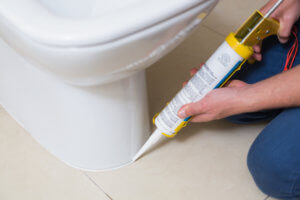
Cracked Base or Loose Seals
Water can leak from cracked toilet bowls or loose floor seals, especially if the toilet shifts with use. Moisture build-up under the toilet can cause mold and sewer odor.
Fix:
- Remove old caulk around the toilet base
- Clean the area thoroughly
- Apply a fresh bead of waterproof caulk around the seal
Dry Shower P-Trap
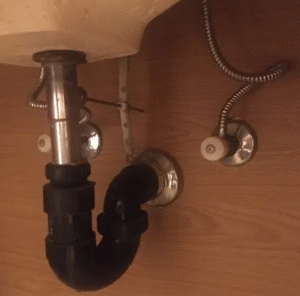
Dry Shower P-Trap
If you haven’t used your shower in a while like in a guest bathroom or after returning from a trip the P-trap may have dried out. This U-shaped pipe is meant to hold water to block sewer gas from rising back into the home.
Fix:
- Run the shower for a minute to refill the trap
- Add a few drops of mineral oil to slow evaporation
Shower Drain Biofilm
If you use soaps, shampoos, or body washes, they can mix with hair and skin cells in your drain and form a layer of bacteria called biofilm. This can trap odors and mimic the smell of sewer gas.
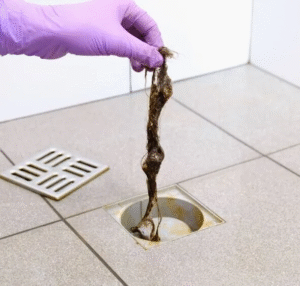
Shower Drain Biofilm
How to clean it:
- Remove the drain cover
- Pour hot water (150°F max) down the drain
- Add 1 cup white vinegar + ½ cup baking soda
- Wait 2 hours
- Pour another gallon of hot water and scrub with a drain brush
Read more about: Home Remedies For A Clogged Drain
2. Bathroom Sink: Don’t Forget the Overflow Hole
Many sinks have a small overflow hole just beneath the faucet. This area often traps soap scum, hair, and bacteria leading to a surprisingly strong sewer-like smell.
How to clean it:
- Use a small bottle brush dipped in vinegar to scrub it out
- Or pour a 50/50 mix of bleach and water down the overflow hole
- Rinse with hot water
Also check the P-trap under the sink it may be dry or partially clogged.
3. Kitchen Sink: Focus on the Garbage Disposal
Your kitchen sink deals with food scraps, grease, and all sorts of liquids. If you have a garbage disposal, the splash guard (that black rubber ring at the top) can trap bits of food and start to smell.
How to Clean the Disposal and Splash Guard
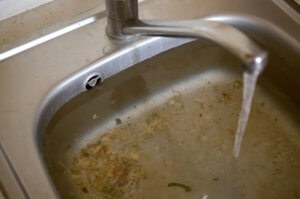
Kitchen Sink
Method 1: Manual Cleaning
- Turn off the disposal
- Flip the splash guard inside out carefully
- Scrub the underside with a brush and dish soap
Method 2: Deodorizing Rinse
- Pour ¼ cup baking soda down the drain
- Wait 10 minutes
- Add 1 cup vinegar
- Let it foam and sit
- Finish with hot water and run the disposal
Bonus Tip: Toss lemon or orange peels into the disposal for a fresh scent.
4. Laundry Room: Washing Machine and Floor Drains
You might not think of your washing machine as a source of sewer odor but it’s connected to your drain system, and things can go wrong.
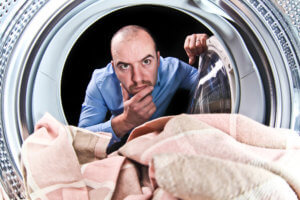
Washing Machine
Washing Machine Drain Odor
Sometimes, smells come from the drain pipe behind your washer or the washer itself.
Fixes to try:
- Run a hot cycle with no clothes + ½ cup baking soda + ½ cup vinegar
- Or run a hot cycle with 1 cup bleach
- Leave the washer door open after use to air it out
Floor Drain Near Washer
Most laundry rooms have a floor drain. If unused, the water in the P-trap can dry out, letting sewer gas rise into the room.
Fix:
- Pour 1 gallon of water into the drain
- Add 4 oz of mineral oil to slow evaporation
5. Basement or Utility Room: Look for Damaged Pipes
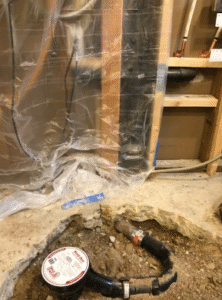
Utility Room
If you’ve checked all your fixtures and still smell sewage, your dr
ain lines themselves might be damaged or cracked especially if you live in an older home with cast iron pipes.
Signs of a Damaged Sewer Pipe
- Unexplained sewer smell near basement walls or floors
- Puddles or wet spots without a clear source
- Cracked or sagging foundation in extreme cases
This is not usually a DIY fix. You’ll need a camera inspection and potentially trenchless sewer repair, which is less invasive and faster than digging up your yard.
6. Roof: Clogged or Blocked Sewer Vent Pipe
Every home has a vent pipe that runs up through the roof. It equalizes air pressure and helps push sewer gase
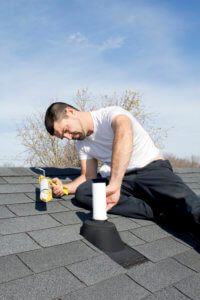
Sewer Vent Pipe
s out. But if this vent gets blocked by leaves, debris, or even a bird’s nest the gases can get forced back into your home.
How to Check the Roof Vent
If you’re comfortable on a roof:
- Carefully check the vent pipe opening
- Remove any visible debris
- Use a plumbing snake if you suspect a clog deep inside
If not:
- Contact a licensed plumber who can clear it safely
Final Thoughts: Eliminate the Smell, Restore Comfort
Sewer odors should never be ignored. Simple fixes may help, but if the smell continues, professional help is the safest choice. New Flow Plumbing in Los Angeles has the experience to find the source, repair it properly, and restore fresh, clean air in your home. Choosing experts means better air quality, a safer environment, and lasting comfort.
FAQs

Arman Grigoryan
Founder & President of New Flow Plumbing
Arman Grigoryan is the founder and president of New Flow Plumbing, proudly serving Los Angeles, Sacramento, and surrounding areas. With extensive experience in plumbing diagnostics, he leads a skilled team specializing in advanced sewer and drain camera inspections to quickly identify problems and deliver lasting solutions. Arman is dedicated to using the latest technology to provide reliable service, honest answers, and dependable results for every customer.

